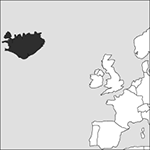
Source: MAPS IN MINUTES™ © RH Publications (1997)
Capital:
Reykjavik
Area:
103,000 sq km (39,769 sq miles)
Population:
315,281 (2013 est)
Currency:
1 króna = 100 aurar
Religions:
Evangelical Lutheran 76.2%; Roman Catholic 3.4%; Christian and other minorities
Ethnic Groups:
Icelandic 94.0%
Languages:
Icelandic (official); English; Nordic languages; German
International Organizations:
UN; EFTA; OECD; NATO; Council of Europe; OSCE; WTO
An island country just south of the Arctic Circle in the north-eastern Atlantic Ocean.
Physical
It is approximately 460 km (285 miles) long by 280 km (174 miles) wide; but only its coastal areas can be used for settlement and agriculture because the rest is a wasteland of ice, ash, and lava flows.
Economy
Hydroelectric power stations provide over three-quarters of the country’s electricity needs and geothermal energy is abundant. Six-sevenths of the land area is agriculturally unproductive. The fishing industry is of vital importance to the economy, accounting for 40% of export earnings; other exports are aluminium (produced from imported alumina) and ferro-silicon. The 2000s saw a rapid expansion of the banking sector followed by its collapse.
History
Iceland was conquered by the Vikings between 874 and 930. Its capital, Reykjavik, was founded, and the country was governed by some 36 chieftains, who met periodically in the Althing, an official assembly. A lawspeaker was appointed, and, in 1005, a Supreme Court. Authority, once derived from the pagan priests and temples, changed with conversion to Christianity in c.1000 to a partnership of Church and Althing. In 1262 Iceland passed to Norway and, in 1380, with Norway to the Danish crown. Under the rule of Denmark since 1380, a nationalist movement achieved the restoration of the Althing or parliament in 1845. Iceland acquired limited autonomy in 1874 and independence in 1918, although it shared its king with Denmark till 1943. It became an independent republic in 1944. An Allied base during World War II, it joined the United Nations Organization and NATO (1949). It engaged in sometimes violent disputes with Britain over fishing limits, resulting in the ‘Cod War’ of 1972–76. In the late 1970s strong opposition to the presence of US bases developed, and Iceland became a nuclear-free zone in 1985. The country’s worsening economic situation in 1992, caused by losses in the fishing industry, led the government to introduce emergency measures and to devalue the króna in 1993. From the late 1990s bank deregulation attracted global capital to Iceland’s financial institutions, which expanded rapidly. By the mid-2000s this boom had left Iceland vulnerable to fluctuations in market sentiment, with its banks having liabilities over ten times the country’s GDP. Iceland’s banking structure imploded in the Credit Crunch of 2008: investors lost confidence and withdrew capital, and Iceland’s three largest banks collapsed. Threatened with national bankruptcy, Iceland favoured domestic customers of these banks for compensation over foreign investors—a policy that caused diplomatic disputes with the UK and the Netherlands. A loan from the IMF and unpopular austerity measures helped to stabilize the economy; but there was a severe recession until 2010 and work to restructure the economy continues. In 2015 Iceland withdrew its application to join the EU. In 2016, Prime Minister Sigmundur Davíð Gunnlaugsson of the Progressive Party was forced to resign following a financial scandal and was replaced by Sigurður Ingi Jóhannsson. After elections later that year, a new coalition was formed led by the conservative Bjarni Benediktsson, leader of the Independence Party. The coalition crumbled following a scandal involving the Prime Minister’s father. In the elections that followed, the Independence Party lost seats and a new coalition was formed by the Left-Green Movement, with Katrin Jakobsdottir becoming Prime Minister in November 2017.